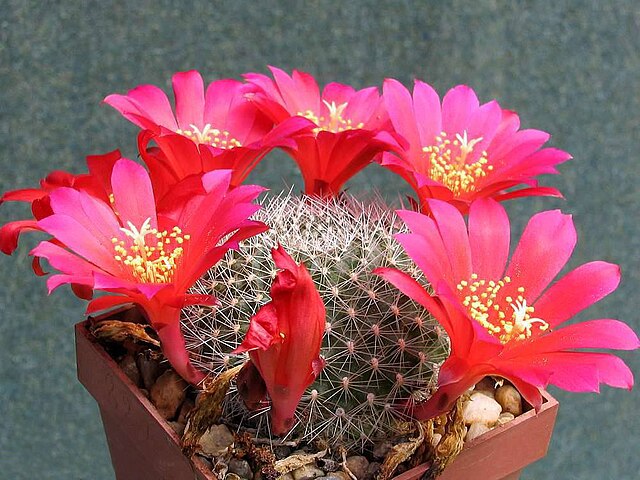Welcome to the fascinating world of Rebutia, a genus that showcases the exquisite diversity and beauty of cacti. Often underrepresented in conversations about succulents, Rebutias warrant attention for their unique morphology, captivating flowers, and ease of care. This guide will illuminate the enchanting characteristics of these diminutive wonders, offering insights that promise to shift your perspective on cacti in general.
Imagine a vibrant ball of spines, punctuated by pulsating blooms that burst like fireworks in the desert. This is the essence of Rebutia, a genus hailing from South America, primarily flourishing in Bolivia and Argentina. With over thirty species, Rebutia is celebrated for its low stature and delightful colors, proving that sometimes the most petite plants can yield the most astonishing art forms. Let us delve into the intricate tapestry that is Rebutia.
Before we proceed, let’s unravel the distinct taxonomy and morphology of these remarkable plants. Amidst the Cactaceae family, Rebutia finds its place as a gem, with a morphology that is both arresting and functional. The typical Rebutia showcases a globular or cylindrical form, enabling it to thrive in harsh environments. The average size ranges from 2 to 10 centimeters in diameter, but don’t let their diminutive stature fool you—these cacti pack a punch when it comes to visual impact. Their spines emerge in a striking array of colors, while the plant itself may exhibit an ornate texture that captivates the eye.
Beyond their size, the flowers of Rebutia stand as a testament to nature’s artistry. These tubular blooms open wide to reveal a dazzling display of color, from vibrant reds and yellows to soft pastels, depending on the species. The ephemeral joy of their blossoms can last several days, offering a brief yet resplendent spectacle that invites pollinators and admirers alike. The pollination of Rebutia, often facilitated by bees and various insects, exemplifies a delicate relationship within ecosystems, underscoring the role that even the smallest plants play in broader biological communities.
Concerning cultivation, Rebutia is a recommended choice for both novice and experienced gardeners. Their resilience and adaptability make them perfectly suited to home environments, whether placed on a sunny windowsill or as part of a larger succulent arrangement. Consider the following cardinal aspects of Rebutia care, each crucial for ensuring robust plant health and an abundance of blossoms.
Light is a vital factor, and Rebutia cacti flourish under bright, indirect sunlight. While they can tolerate direct rays, especially during the cooler seasons, extremes of heat can lead to scorch. A well-placed pot near a south or west-facing window often proves ideal. If you notice your Rebutia stretching or becoming leggy, this signals insufficient light, necessitating a change in location.
Watering, another essential element of care, deserves meticulous attention. Rebutias are succulents and thrive in well-draining soil, making overwatering one of the most common pitfalls for caretakers. During the growing season, typically from spring to autumn, water when the top inch of soil feels dry, allowing water to thoroughly soak through the drainage holes. As winter approaches, reduce watering frequency to mimic their native habitats where they experience drought-like conditions.
Soil types matter, as they provide the requisite drainage and aeration necessary for root health. A cactus-specific potting mix, often infused with perlite or sand, provides an excellent environment for Rebutia, preventing common ailments related to stagnant moisture. The pH of the soil should remain neutral to slightly acidic—a crucial detail for optimal growth.
Fertilization enhances growth but must be approached with caution. During the active growing season, a diluted cactus fertilizer serves to nourish these plants without overwhelming them. Too much fertilizer can lead to succulent burn, turning vibrant plants into limp reminders of their former glory. Thus, when nourishing your Rebutia, moderation is paramount.
Pest management is another aspect of cultivation that warrants diligence. While Rebutia is relatively pest-resistant, vigilant checking is wise. Common pests include mealybugs and spider mites. A gentle soap solution can often remedy infestations, restoring the plant’s vitality. Monitoring your plants regularly allows for prompt action and ensures the health of your Rebutia.
Diving deeper into species diversity reveals a world of captivating variations, each with its own quirks and attributes. The following examples present a small selection but are noteworthy for their distinctiveness.
Rebutia muscula, known for its petite size and vibrant yellow blooms, captures the hearts of many enthusiasts. Often referred to as the “Chihuahuan button cactus,” this species embodies a cheerful disposition with its bright flowers, effectively dispelling any gloom with a splash of color.
Another captivating species is Rebutia fiebrigii, distinguished by its strikingly spiny exterior coupled with resplendent red blossoms. This species has attracted attention for its dramatic presentation, making it a favorite amongst collectors and horticulturists alike.
For those in search of something unique, Rebutia Kunterbunt may pique interest. Often characterized by the splendid patchwork of colors on its surface, this cultivar is a conversation starter, as its splashes of color touch nearly every hue in the rainbow. The fascination it inspires showcases the beauty of biodiversity within the genus.
Rebutias flourish if attentively cared for, enriching gardens and homes alike. These cacti exhibit remarkable traits worth celebrating. Beyond their aesthetic appeal, they symbolize a broader ecology—an intricate interplay of survival and beauty amidst the harshness of their native environments. As such, the cultivation of Rebutia beckons support for biodiversity, sustainable gardening practices, and an acknowledgment of the delicate balance of our ecosystems.
In conclusion, navigating the world of Rebutia can be a rewarding adventure. These cacti promise not only aesthetic delight but also the opportunity to engage with nature’s complexity. For those ready to embrace the robust character and delicate beauty of Rebutia, the journey begins with understanding their needs and appreciating their unique contributions to our planet. With proper care and a dash of curiosity, these small wonders will undoubtedly thrive, leading to a profound appreciation for the oft-overlooked beauty nestled within the desert.

Leave a Comment